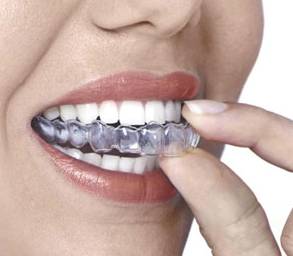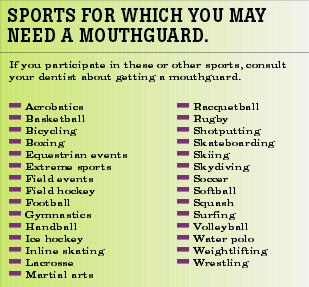 Mouthguards should be considered mandatory equipment for athletes and sports enthusiasts, especially if your sport is a “contact” sport.
Mouthguards should be considered mandatory equipment for athletes and sports enthusiasts, especially if your sport is a “contact” sport.
Can you imagine what it would be like without one or two of your front teeth? It’s hard to appreciate how important these teeth are until they’re missing. Face-to-face conversations with other people would be awkward; you’d have difficulty pronouncing certain words; and you probably wouldn’t smile much. Not to mention popular foods like pizza would be all but impossible to eat.
Children, teenagers and active adults experience thousands of injuries every year. Whether it’s on a ball field, basketball court, biking, skateboarding, or any number of other activities, protecting one’s teeth is of paramount importance.
Facial injuries in most of these sporting endeavors are almost inevitable if you play long enough and hard enough. These injuries can harm teeth, lips, cheeks and the tongue. You can read this article describing how a contact injury caused a tooth to die and what it took to repair it.
The good news in almost all of these cases is that a properly fitted mouthguard or sports mouthpiece can protect your teeth and smile. As we said earlier, the mouthguard should be considered just as essential a piece of your equipment as a bat or ball to a baseball player.
The obvious contact sports like football, boxing and hockey have been using mouth guards for a long time and these protectors are considered a normal part of the sport.
But other recreational sports activities should consider using mouthguards as well. The mouthguards help protect teeth even in sports that are traditionally considered non-contact sports … sports such as gymnastics. If you can imagine a way to receive a facial injury or injury to the mouth either by falling or making some other blunt force contact to the face in your sport, then you should consider a sports guard. Experts suggest the same.
What’s involved in choosing Mouthguards for Sports?
There are three types of mouthguards:
1) the ready-made, or stock, mouthpiece;
2) the mouth-formed “boil-and-bite” mouthguard;
3) the custom-made mouthguard made by a dentist.
All properly fitted mouthguards provide varying degrees of protection. The advantage of a custom-fitted mouthguard professionally made in the dental office is readily apparent compared to the over-the-counter types.
Anytime a mouthguard can be personally fitted and developed around the individual demands of the athlete and the sport, it will be a superior choice.
Features of a good mouthguard
An effective mouthguard should be:
- resilient,
- tear-resistant
- comfortable
- durable
It also should fit properly, be easy to clean, and should not restrict speech or breathing. Mouthguard straps are also helpful to keep from losing the guard when the athlete is not in play and make it convenient to attach the guard to a facemask or helmet.
Mouthguards generally only cover the upper teeth. Occasionally the dentist will recommend a lower guard to protect the lower teeth of patients with a protruding jaw.
Below is a screenshot of the activities for which the American Dental Association and the International Academy for Sports Dentistry recommend that you wear a properly fitted mouthguard.
The listed sports in the graphic above have the potential to seriously harm the head, face or mouth as a result of contact, including head-to-head contact, falls, tooth clenching or blows to the mouth. A well-made, properly fitted mouthguard is highly recommended for use in any of these sports.
How to care for your mouthguard
Before and after each use, the mouthguard should be rinsed with cold water or with an antiseptic mouth rinse. It can be cleaned with toothpaste and a toothbrush, too. When not in use it is best to place the mouthguard in a storage container that is firm (unlike a plastic baggy) and breathable with perforated holes in the container. This allows for air circulation and prevents damage.
High temperatures should be avoided … watch out for hot or boiling water, any hot surfaces or direct sunlight. These hot conditions can distort the shape of the mouthguard.
Routinely check the guard for tears and holes and make sure the fit still feels correct. Also if the guard has a strap, check it for integrity to avoid losing the mouthguard.
The condition of the mouthguard is important to monitor also as it can irritate your mouth and offer less than adequate protection if worn or in bad shape. As in all dental care, it is important to have regular dental checkups, and it’s a good idea to bring your mouthguard along so our Raleigh Dentists at Gover and Gover can verify that it’s still in good condition.

